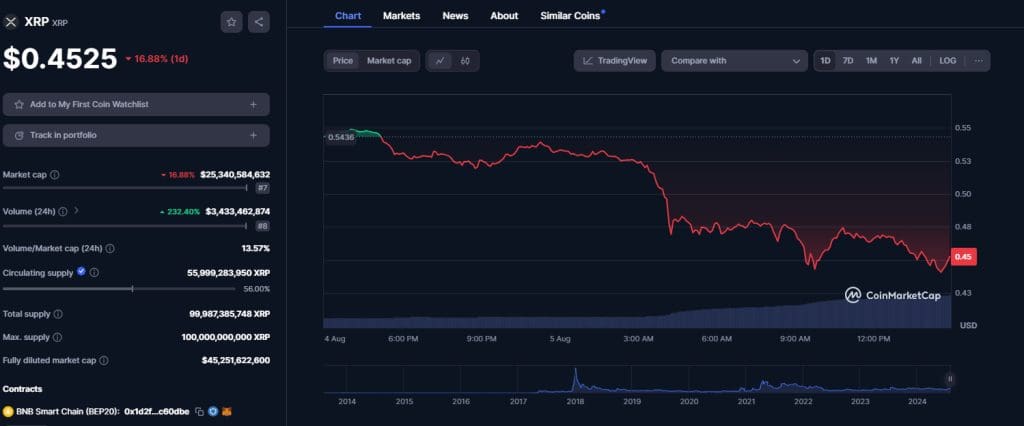Solana (SOL) may never reach $1,000 due to supply growth
Solana (SOL) may remain pressured by relatively high inflation. The lack of a clear supply cap and the ongoing unlocks can continue to put pressure on SOL even without negative market conditions.
Solana (SOL) is the most inflationary among blue chip tokens, with yearly inflation at more than 5%. The inflation is built into the protocol and is needed to motivate validators to produce blocks. Part of the inflation is offset by locking SOL for staking, which at least takes the tokens off the market.
But SOL investors are warning that Solana has always posted ties to venture capital backers, and may be pressured by ongoing selling of significant positions.
Some of the SOL price predictions see the asset rise as high as $1,000 to rival Ethereum (ETH). Solana still has close to four times the supply of ETH, but its network is still catching up in terms of daily activity and value locked. However, some see the rally to $1,000 as an impossible feat, as Solana’s backers are more willing to sell than to hold for the long term. Retail SOL buyers may be incentivized to stake their tokens, but fears of VC selling are still mentioned as the biggest factor for Solana.
Still don’t understand people YOLOing into $SOL at the top as supply continues to increase and VCs continue to dump on them. Read the room bruh, find a 💎 that has a bright future but hasn’t had its run yet. pic.twitter.com/6ngAFd7fBh
— Alts Anonymous 🧐 🆙 (@Alts_Anonymous) August 4, 2024
The Solana network raised suspicion due to its support from the FTX exchange, which held a large part of the token’s supply. SOL survived the crash of FTX, though never recovering its peak levels close to $260.
The FTX influence may not be over – there have been rumors of a secret wallet holding 8% of the total SOL supply. A whistleblower has come forward with information of a previously undisclosed wallet, built by FTX and Alameda Research. The 6M SOL tokens are a risk to the market, if they are sold directly. Even if disclosed, the wallet may still lead to selling to reimburse creditors.
The current market cycle took SOL close to $200 with a consistent baseline above $130. The bounce from lows under $10 sparked hopes that SOL could outperform in the future. But the growing supply is built into the network’s code and SOL may not perform in a similar way in the future.
Solana expands supply due to the need for subsidies
On the surface, Solana looks like a cheap and fast blockchain. But to achieve that performance, Solana needs to subsidize validators. Those events require the issuance of new tokens, as well as using reserves, and increasing the supply of available SOL.
The Solana network is constantly logging net losses due to its reward program, required for each block produced. The Solana network thus logs monthly losses of over $300M. Additionally, SOL retail users still need to pay base fees, priority fees and lately, direct tips to validators to make sure their transaction is included in a block.
In May, validators also voted in favor of receiving higher SOL rewards for every block, without burning part of the fees. The policy of Solana is more inflationary than Ethereum (ETH), which continues to burn fees. Solana has no Layer 2 solutions and still relies on direct transactions, especially for DEX trading. But without burns, it means validators are still sitting on a growing supply of coins and tokens.
With the current levels of inflation, some of the weight is already felt on the market. In the past 12 months, the supply of SOL rose by more than 60M tokens, starting out at 402M SOL as of August 2023. The supply also added 10M SOL within days in May, followed by the usual gradual expansion.
SOL now has 465.47M tokens in circulation, with expectations of expanding to 1B tokens in the future. The SOL market must be able to absorb the new rewards and incentives, or be unable to retain validators. So far, the market has absorbed a supply inflation of 60% in three years, but the ongoing injection of new tokens may keep SOL permanently in a range.
SOL traded at $121.26 after the most recent market crash, abandoning a recent peak at $194. SOL rallied previously, as the leading validator JitoSOL also announced liquid staking and liquid re-staking, but the news was not enough to forestall the correction.
Cryptopolitan reporting by Hristina Vasileva



![Bitcoin [BTC] Teeters on Edge of $50k Amidst Global Market Turmoil and Investor Panic](https://en.coinotag.com/wp-content/uploads/2024/05/cryptocurrencies-5.webp)


